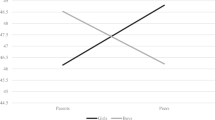Abstract
Literature on friendships of adolescents and young adults suggests important gender and age-related differences. In a study of transitions in relationship style from middle adolescence (high school) to late adolescence (college), 300 students described their relationship with the person who was closest to them, either same or other sex. Four relationship styles were characteristic: integrated (high friendly and high intimate), intimate (high intimate and low friendly), friendly (high friendly and low intimate), and uninvolved (low intimate and low friendly). Women's more intimate styles of relating, as compared to men's more uninvolved styles, suggested that women developed earlier competence at intimate relating than did men. Viewed as particularly important were the college women's close friendships with those of the same gender, an experience uncharacteristic of adolescent men in high school and college. Results were discussed in terms of Erikson's stages of development and Sullivan's concept of the chum.
Similar content being viewed by others
References
Bailey, R. C., Finney, P., and Helm, B. (1975). Self-concept support and friendship duration.J. Soc. Psychol. 96: 237–243.
Balswick, J. O., and Peek, C. W. (1971). The inexpressive male.Fam. Coord. 20: 363–368.
Bem, S. L. (1974). The measurement of psychological androgyny.J. Consult. Clin. Psychol. 42: 155–162.
Bigelow, B. J. (1977). Children's friendship expectations: A cognitive developmental study.Child Dev. 48: 246–253.
Coutts, R. L. (1973).Love and Intimacy, Consensus, San Ramon, Calif.
Davis, M. S. (1973).Intimate Relations, Free Press, New York.
Douvan, E., and Adelson, J. (1966)The Adolescent Experience, Wiley, New York.
Duck, S. W. (1975). Personality similarity and friendship choices by adolescents.Europ. Soc. Psychol. 5: 351–365.
Erikson, E. H. (1968).Identity: Youth and Crisis, Norton, New York.
Fischer, J. L., and Narus, L. R. (1981). Sex roles and intimacy in same sex and other sex relationships.Psychol. Woman Quart. 5 (in press).
Gallatin, J. E. (1975).Adolescence and Individuality, Harper & Row, New York.
Glazer-Malbin, N. (1975). Factors, variance and loadings of individual items, 3rd rev. Sociology Department, Portland State University, Portland, Ore.
Johnson, M. P. (1973). Commitment: A conceptual structure and empirical application.Sociol. Quart. 14: 395–406.
Hodgson, J. W., and Fischer, J. L. (1979). Sex differences in identity and intimacy development in college youth.J. Youth Adoles. 8: 37–50.
Josselson, R., Greenberger, E., and McConochie, D. (1977a). Phenomenological aspects of psychosocial maturity in adolescence. Part I.Boys. J. Youth Adoles. 6: 25–56.
Josselson, R., Greenberger, E., and McConochie, D. (1977b). Phenomenological aspects of psychosocial maturity in adolescence. Part II. Girls.J. Youth Adoles. 6: 145–168.
Lyness, J. L. F. (1973). Reciprocal relationships in families with a disturbed or nondisturbed child. (Doctoral dissertation, University of Colorado.) University Microfilms, Ann Arbor, Mich., No. 74-12, 390.
Mannarino, A. P. (1976). Friendship patterns and altruistic behavior in preadolescent males.Dev. Psychol. 12: 555–556.
Mannarino, A. P. (1978). Friendship patterns and self-concept development in preadolescent males.J. Genet. Psychol. 133: 105–110.
Modell, J., Furstenberg, F., and Hershberg, T. (1976). Social change and transitions to adulthood in historical perspective.J. Fam. Hist. 1: 7–32.
Mulcahey, G. A. (1973). Sex differences in patterns of self-disclosure among adolescents: A developmental perspective.J. Youth Adoles. 2: 343–356.
Newman, B. M. (1975). Characteristics of interpersonal behavior among adolescent boys.J. Youth Adoles. 4: 145–154.
Orlofsky, J. L. (1976). Intimacy status: Relationship to interpersonal perception.J. Youth Adoles 5: 73–88.
Orlofsky, J. L., Marcia, J., and Lesser, I. M. (1973). Ego identity status and the intimacy versus isolation crisis of young adulthood.J. Personal. Soc. Psychol. 27: 211–219.
Reisman, J. M., and Shorr, S. I. (1978). Friendship claims and expectations among children and adults.Child Dev. 49: 913–916.
Rivenbark, W. H. (1966). Self-disclosure and sociometric choice in the adolescent period. Doctoral dissertation, University of Florida.
Sullivan, H. S. (1953).The Interpersonal Theory of Psychiatry, Norton, New York.
Van der Veen, F., and Novak, A. L. (1974). Perceived parental attitudes and family concepts of disturbed adolescents, normal siblings and normal controls.Fam. Proc. 10: 327–343.
Walker, L. S., and Wright, P. H. (1976). Self-disclosure in friendship.Percept. Mot. Skills 42: 735–742.
Weiss, L., and Lowenthal, M. F. (1976). Life-course perspectives on friendship. In Lowenthal, M. F., Thurnher, M., and Chiriboga, D. (eds.),Four Stages of Life, Jossey-Bass, San Francisco, pp. 43–61.
Weiss, R. (1974).Loneliness: The Experience of Emotional and Social Isolation, MIT Press, Cambridge, Mass.
Wright, P. H. (1974). The delineation and measurement of some key variables in the study of friendship.Rep. Res. Soc. Psychol. 5: 93–96.
Author information
Authors and Affiliations
Additional information
Received Ph.D. in social psychology from the University of Colorado. Major interests are relationship style, intimacy development, and transitions to adulthood.
Rights and permissions
About this article
Cite this article
Fischer, J.L. Transitions in relationship style from adolescence to young adulthood. J Youth Adolescence 10, 11–23 (1981). https://doi.org/10.1007/BF02088419
Received:
Issue Date:
DOI: https://doi.org/10.1007/BF02088419



